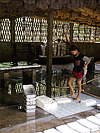|
rubber
Tough elastic substance which is obtained from the latex of
the
rubber tree.
Its name was bestowed by the British scientist Joseph Priestley after he
discovered its ability to erase or ‘rub out’ pencil marks. Rubber is collected
from trees which trunks are gouged, causing the sap to run down into a tap that
then drips into a small cup (fig.),
a process known as rubber tapping. In South America where the tree is a native,
Indians call it ‘cachuchu’, the wood that weeps. The cut must be made perfect,
as the yield would drop dramatically when the wound is too deep or not deep
enough. Every tree is scored afresh every 2-3 nights, before sunrise and when it
doesn't rain. After the cutting, the collecting starts, emptying all small cups
into buckets. This has to be done hastily, before the rubber begins to harden.
Once the sun rises it's too late: the rubber would harden, be spoiled and
useless (fig.).
After collecting the crude rubber it is transferred into large barrels, diluted with water and treated with acid to coagulate the
particles. Then, it is poured into pans to harden (fig.),
after which it is trampled on by barefooted workers, to expand the
surface and compress the matter a first time, before being mangled
into white, pliable sheets or mats, that are then hung to dry in the
sun (fig.).
While drying, they turn yellowish-beige (fig.).
In history, Indians were using rubber long before its introduction to Western
civilization. It wasn't until 1736, when explorer Charles Condamine sent back
home several rolls of crude rubber produced by Indians from wild trees in the
Amazon Valley, that scientists got gradually interested. Long before its
commercial application had been discovered the British industrialist Samual Peal
found cloth could be waterproofed by rubbing it with a solution of rubber and
turpentine. In 1839, the American inventor Charles Goodyear discovered that if
you vulcanized rubber by cooking it with sulfur it would no longer become stiff
in cold weather or sticky and smelly in the heat. This chemical
process of vulcanization, in which natural rubber is converted into
a more durable material by adding sulfur, was named after Vulcan,
the ancient Roman god of fire. South America remained the
first source of crude rubber until 1876 when the Briton Sir Henry Wickham
germinated around 70,000 hevea brasiliensis seeds smuggled from Brazil and
successfully planted them in Ceylon. Soon after rubber trees were planted in
Malaysia as well. When in the beginning of the 20th century tin supplies on the
island of
Phuket declined Thailand got in on the act, planting its first rubber tree in 1903.
King
Rama V also assigned a new governor to
Trang province to set out local rubber production there and by 1936 Thailand was
producing 4% of the world rubber market. The end of the boom began with the
outbreak of WW II when a cost effective way to produce synthetic rubber was
devised, but Thailand still produces around 2 million tons of rubber a year,
worth some 60 billion baht and making it the world's biggest producer of crude
rubber. In a good year the yield could be as much as 500 kilograms of raw rubber
per hectare. Besides its surgical and aviation uses, rubber is used in a variety
of products, from elastic bands to car parts, etc. Also called
para rubber.
WATCH VIDEO
and
VIDEO (E).
回






|

